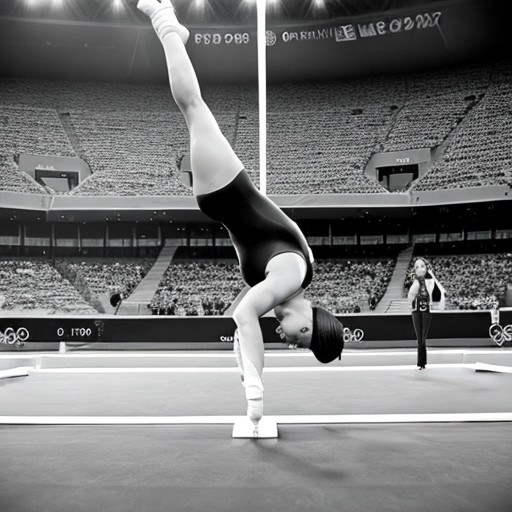Gymnastics

Gymnastics is a sport that involves a combination of strength, flexibility, balance, and artistic elements. It is often performed as a competitive sport in various events, both individually and as part of a team
read more sports Gymnastics ,Basketball ,Wrestling Sport ,IPL Records ,Test Crickets matches Records
Gymnastics History: Gymnastics goes way back to ancient times, like when the ancient Greeks used to do gymnastic exercises. They wanted to stay strong and fit.
Types of Gymnastics: There are different kinds of gymnastics, like artistic, rhythmic, trampoline, and acrobatic. Each type has its own cool stuff to do.
Artistic Gymnastics: This is the one you often see in the Olympics. Men and women do amazing things on different things like bars, beams, and mats.
Rhythmic Gymnastics: In this, people mix dance and gymnastics, using things like ribbons and hoops.
Trampoline Gymnastics: People jump on trampolines and do tricks in the air. Some do it alone, and some do it with others at the same time.
Acrobatic Gymnastics: Groups of people do moves together, like lifting each other in the air or making cool shapes.
Tumbling: Tumbling is about doing flips and rolls on a long bouncy track.
Training and Skills: People start practicing gymnastics when they’re young to get really good at it. They need to learn how to do moves safely and with the right technique.
Competitions: Gymnasts show off what they can do in competitions. Judges give scores based on how well they do their moves and how hard they are.
Conclusion: Gymnastics is an old sport with lots of different types. People do impressive tricks and moves while staying strong and flexible. It’s also fun to watch in the Olympics and other events!
Gymnastics in the Olympics follows a set of rules and a scoring system
Code of Points: The Code of Points (CoP) is the rulebook that outlines the specific requirements and scoring criteria for each gymnastics routine. It is periodically updated by the International Gymnastics Federation (FIG).
Difficulty Score (D-Score): The difficulty score is based on the elements and skills performed in the routine. Gymnasts receive points for the difficulty of their routine, which are determined by the complexity of their skills, combinations, and connections. Judges assign a D-score based on the elements performed.
Execution Score (E-Score): The execution score is based on how well the gymnast performs the routine. Judges deduct points for mistakes, lack of control, form errors, and other imperfections in the execution of skills.
Connection Value: In some events, like women’s uneven bars and balance beam, and men’s horizontal bar, gymnasts receive bonus points for successfully connecting difficult skills in a routine. These connections must be performed seamlessly and with precision.
Artistry and Presentation: Judges also evaluate the gymnast’s artistry, presentation, and overall performance quality, which can impact the E-score.
Penalties: Penalties are applied for various infractions, such as stepping out of bounds, falling, or exceeding the time limit for a routine.
Final Score: The final score for a gymnast’s routine is calculated by adding the D-score and E-score and subtracting any applicable penalties. The total score determines the gymnast’s ranking in a particular event.
Tiebreakers: In the event of a tie, the gymnast with the higher D-score is typically ranked higher. If there is still a tie, the E-scores are used to break it.
Team and All-Around Scores: In team competitions and the all-around individual competition, gymnasts’ scores are combined to determine the team or all-around rankings.
Gymnastics olympic medliest players
Men’s Artistic Gymnastics:
- Vitaly Scherbo (Belarus) – He won 6 gold medals and 4 silver medals in the 1992 Barcelona Olympics.
- Nikolai Andrianov (Soviet Union) – He earned 7 gold medals, 5 silver medals, and 3 bronze medals over the course of the 1972, 1976, and 1980 Olympics.
- Boris Shakhlin (Soviet Union) – He won 7 gold medals, 4 silver medals, and 2 bronze medals during the 1956
Top Women's Gymnastics Olympic Champions
Simone Biles (USA): She’s one of the best ever, winning lots of gold medals.
Larisa Latynina (Soviet Union): A star in the 1950s and 1960s, winning many Olympic medals.
Nadia Comăneci (Romania): She wowed everyone in 1976 with perfect 10.0 scores and won many golds.
Vera Caslavska (Czechoslovakia): She won gold medals in the 1960s and was known for her cool routines.
Nellie Kim (Soviet Union): A top gymnast in the 1970s and 1980s, especially on the uneven bars.
Svetlana Khorkina (Russia): She ruled in the late 1990s and early 2000s, especially on the bars.
Gabby Douglas (USA): Part of the “Fierce Five,” she won gold in the all-around in 2012.
Aly Raisman (USA): Another “Fierce Five” member, winning golds in 2012 and 2016.
Olga Korbut (Soviet Union): A gymnastics pioneer in the 1970s, known for her flips on the bars.
Shannon Miller (USA): A star in the 1990s, with gold in the all-around in 1996.
